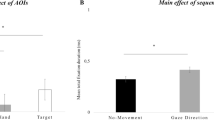Abstract
Kleck has discovered more eye contact directed toward a handicapped than a nonhandicapped confederate. He suggested that this was due to the information seeking function of eye contact. Langer et al. argued that this occurred because a handicap is a novel stimulus and that, when socially acceptable, people are motivated to look at something unusual. The present study posited that Kleck's findings occurred because of the experimental setting and that the Langer et al. hypothesis holds true only when interaction with the handicapped person will not occur. A field experiment indicated less gaze toward and more avoidance of handicapped than nonhandicapped confederates when conversation was required and more staring toward the handicapped than the nonhandicapped when conversation was not likely.
Similar content being viewed by others
References
Davis, F. Deviance disavowal: The management of strained interaction by the visibly handicapped. In H. Becker (ed.)The other side: Perspectives on deviance. New York: Macmillan, 1961.
Exline, R. V., & Winters, L. C. Affective relations and mutual glances in dyads. In S. S. Tomkins & C. E. Izards (Eds.)Affect, cognition and personality. New York: Springer, 1965.
Goffman, E.Stigma: Notes on the management of spoiled identity. Englewood Cliffs, N. J.: Prentice-Hall, 1963.
Kendon, A. Some functions of gaze direction in social interaction.Acta Psychologica 1967,26 22–63.
Kleck, R. Physical stimga and nonverbal cues emitted in face-to-face interaction.Human Relations 1968,21 19–28.
Langer, E. J., Fiske, S., Taylor, S. E., & Chanowitz, B. Stigma, staring and discomfort: A novel-stimulus hypothesis.Journal of Experimental Social Psychology 1976,12 451–463.
Newcomb, T. M. Autistic hostility and social reality.Human Relations 1947,1 69–86.
Richardson, S. A., Hastorf, A. H., Goodman, N., & Dornbusch, S. M. Cultural uniformity in reaction to physical disabilities.American Sociological Review 1961,26 241247.
Thompson, T. L., & Seibold, D. R. Communication between the stigmatized and “normals”: A test of the disclosure hypothesis and a model of stigma acceptance.Human Communication Research 1978,4 231–242.
Wright, B. A.Physical disability: A psychological approach. New York: Social Science Research Council, 1960.
Yuker, H. E., Block, J. R., & Campbell, W. J.A scale to measure attitudes toward disabled persons. Human Resources Study, 1966, #7.
Author information
Authors and Affiliations
Additional information
Portions of this article were reported by Teresa L. Thompson and Bonnie Bell Cundiff, “Communication between the handicapped and nonhandicapped: Avoidance and uncertainty,” Presented at the Annual Convention of the International Communication Association, Philadelphia, 1979. The author would like to thank Louis P. Casella for helpful assistance.
Rights and permissions
About this article
Cite this article
Thompson, T.L. Gaze toward and avoidance of the handicapped: A field experiment. J Nonverbal Behav 6, 188–196 (1982). https://doi.org/10.1007/BF00987067
Issue Date:
DOI: https://doi.org/10.1007/BF00987067




